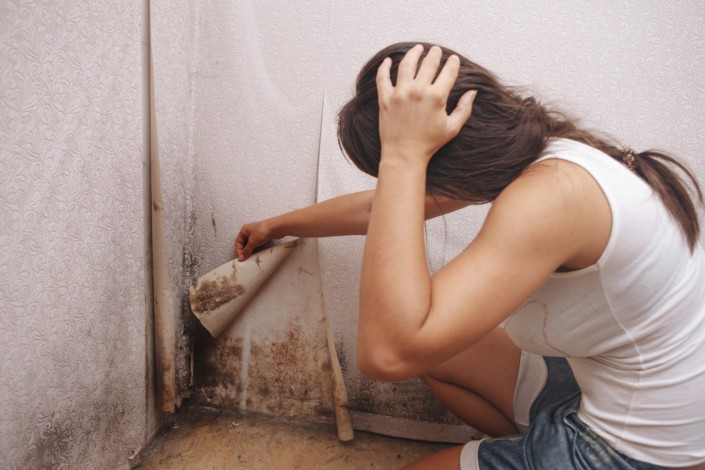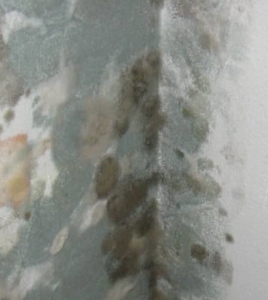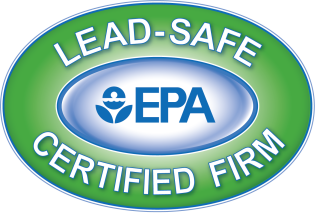Have you found mold on the interior walls of your home? What causes mold to grow anyway? If you do find it, how do you get rid of it? We answer all your questions and more!
DISCLAIMERS:
Blog information is NOT intended to provide or replace medical advice. NO information on this site should be used to diagnose, treat, prevent or cure any disease or condition.
*As an Amazon Associate we earn from qualifying purchases.
Suggestions for products to use are just that, suggestions. You know yourself and your home best. Please do your own research on any product you use in your home or on your skin, and learn all the facts for yourself. Thank you.
WHAT IS MOLD? WHERE DID IT COME FROM?

What is mold anyway? Where did it come from? Why do I have mold in my home? Of course the most important question is… How do I get rid of it!?
What is mold? Molds are fungi, and grow from microscopic spores that are everywhere in the air. From the arctic to equator and all the places in between, mold lives literally everywhere. Molds are important for recycling organic matter (such as leaves). The recycling process they perform returns nutrients to the soil, and is important for plants to grow.
Fungi eat things that are dead like leaves, wood, grass clippings, drywall, carpet, basically all the things from which your home is made. Of course you don’t want molds to eat your home!
There is a way to stop mold from growing in the first place. In order to grow, molds need four things: oxygen, moisture, a food source, and the right temperature range (ideal is between 77F – 86F). It is difficult to impossible to control the temperature and amount of oxygen in the unconditioned spaces in your home (attic, crawlspace, behind cabinets, etc.) So, let’s think about the things you can control when it comes to mold.
Food Sources
Molds grow inside of their food sources. They penetrate deeply into drywall, carpets, floors, cabinets, underneath kitchen and bathroom sinks, etc. Anything with carbohydrates in it could be considered a food source for molds. So it is NOT possible to control food sources, oxygen or temperature. Can you control anything when it comes to mold?
Moisture
Yes! Moisture is the one thing you can reasonably control when it comes to mold. A dry home equals a home with much less mold growth. Keeping areas dry, especially areas that use water frequently (like bathrooms), is important to prevent mold growth.
How Fast Do Molds Grow?
Moisture behind baseboards and cabinets, wet carpet tack strips, in crawl spaces, basements, and other hard to reach areas are a ticking mold time bomb. Once enough moisture is present, molds can begin to grow in less than 48 hours! Time is not on your side!
SYMPTOMS OF MOLD IN YOUR HOME
Sometimes you can visibly see or smell mold growing, but other times it is more difficult to detect. Tight spaces such as in attics, behind cabinets, and in crawl spaces are not places people are likely to venture.
There are 3 ways to tell if you have mold: 1 you might see it, 2 you will probably smell it, but 3 a comprehensive mold inspection by Branch Environmental will definitely find it! The best way to know if you have mold is to get a comprehensive mold inspection performed. Keep reading to learn more about how you can identify the symptoms of mold in your home, and why a professional inspection is so important.
Mold on Interior Walls – What Does Mold Look Like?

In one word… Yes.
All molds have the potential to cause irritation and allergy symptoms. It is important to note that the longer you are exposed to the mold, the more pronounced your symptoms become. At first, it might just be allergy symptoms, but over time (weeks, months, years) mycotoxins build up in your system, and can make you sicker and sicker.
Not all molds are toxic, but many are. Mycotoxins can cause health problems ranging from poisoning to cancer. You can be affected by mycotoxins even if you are not allergic to mold.
Before we go any further, let’s clear up the confusion about ‘toxic black mold.’ When you read about ‘toxic black mold’ it is kind of misleading. The thing is… dangerous and toxic mold is not just black, it can be many different colors. (see illustration above) Toxic molds can appear to be green, yellow, brown, and black. Any of the colors you see could be producing mycotoxins. You can’t tell if mycotoxins are present just by looking or smelling. You have to perform a laboratory test.
So, What is a Mycotoxin?
, literally ‘fungus poison’ in Latin, are secondary metabolites that can be produced by molds, and are not living organisms. Mycotoxins are a byproduct of mold. Not all mold spores produce mycotoxins, but some do. So the molds that produce mycotoxins are the ones that could be categorized as toxic or poisonous.
So, where is the line between an allergic mold and a toxic mold? That line is defined by the presence of mycotoxins, and is NOT defined by color. Mycotoxins are invisible and cannot be detected just by looking at the mold growth.
What Do Mycotoxins Do?
These chemical substances can cause many health problems ranging from mild to severe. Even if you are not allergic to mold, you can be affected by mycotoxins.
Mycotoxins can be absorbed by the body in a number of ways including: through the skin, the airways (inhalation), and through the intestinal lining (ingestion). Detrimental health effects caused by mycotoxins can range from “acute poisoning to long-term effects such as immune deficiency and cancer.”2 Chronic disease sufferers, such as people with immunosuppressive disorders or underlying lung disease may be more sensitive to molds and mycotoxins in their environment.4
The main ways people and pets become poisoned by mycotoxins include breathing contaminated air or eating contaminated foods. Simply breathing contaminated air can introduce the mycotoxins into your lungs! Foods such as apples, cereal grains, coffee beans, nuts, spices, dog and cat food, and more can become contaminated with fungi that produce mycotoxins.
Mycotoxins are NOT something you want in your home! Keep reading to learn how you can remove them. To learn more about mycotoxins in foods check out the World Health Organization’s article: Mycotoxins.
To learn more about how mold affects your pets check out our article: Mold and Pets – 10 Things You Most Likely Didn’t Know.
Mold on Interior Walls – What does mold smell like?
Do you smell that? Did you forget to wash your gym clothes? Does the dog need a bath? I cleaned everything, and I can’t find the stench! It’s so musty! What could it be?! If this sounds like your home or office, you might have a problem with mold and MVOC’s.
MVOC’s or Microbial Volatile Organic Compounds are compounds created by fungi and bacteria during their metabolic processes. MVOC’s can be detected by simply smelling the air. The smell of MVOC’s has been compared to stinky socks, locker room odor, wet dog, or old cheese. They give off a distinctly musty, moldy smell.
There are over 200 compounds that have been identified as MVOC’s. MVOC’s can be dangerous and even toxic to humans. MVOC’s can be mycotoxins or can cause allergy symptoms. It depends on which ones are present. The only way to determine what MVOC’s are present is through laboratory testing. However, if you smell odors like this, you may have a mold problem in your building, and you don’t want to keep breathing them in!
There are also compounds called VOC’s or volatile organic compounds that can be produced by household cleaners, paints, aerosols, disinfectants, air fresheners, glues, and even furniture. VOC’s are not caused by mold or other microbes, and give off a distinctly chemical scent. VOC’s can cause health problems as well.
What Kinds Of Damage Can MVOC’s Cause?
There have been over 200 different chemical compounds identified as MVOC’s that are produced by fungi and bacteria. The chemicals produced include alcohols, arsenics, benzenes, toluenes, acids, sulfur compounds, and many more. Many but not all of these chemicals are mycotoxins and are harmful to people and pets simply by breathing them in.
Please remember that this blog is NOT intended to replace medical advice, diagnosis, or treatment.
To learn more about how mold can affect your health, check out our post: Health Effects of Black Mold.
WHAT DO YOU DO IF YOU FIND MOLD ON INTERIOR WALLS OR OTHER PLACES?
So, hopefully we have convinced you by now that you don’t want to live with mold! Now that you’ve found it, what do you do?
Removing mold can be a DIY project, but it’s a good idea to know when to call the pros. Our tips for mold removal help you know what to use, and what not to use. We can help you remove the mold safely, whether you choose to DIY or call the professionals. We want to help you get back to living your best life in a healthy, mold-free home!
Step 1 – Get a Professional Mold Inspection
Your first step should be a comprehensive mold and indoor air quality inspection from a professional mold removal company. The main reason you want an inspection, even if you can see the mold, is that mold is tricky. Mold grows inside of its food sources and you probably can only see a part of the problem. An inspection will help you find all the mold and define how much damage really exists.
The company you choose for the inspection should offer a comprehensive mold inspection that you pay for, not hand over a price without truly investigating the problem. Your inspector should define the extent of the necessary work and what may or may not need to be done. The inspector should talk you through all your options and tailor a plan that fits your needs and your budget.
Check out our post: Do You Have Mold? How to Choose Between a Paid or Free Mold Inspection to learn about a problem we helped a homeowner with that was NOT mold.
Step 2 – Can I clean the mold on the interior walls myself or do I need a professional?
Mildew (mold’s cousin) is usually easy to remove from hard surfaces, and is easily a DIY project. Mold however is a different story. Customers often ask us, “Can I clean the mold myself or do I need a professional?”
Our answer depends several factors including:
- how extensive the mold problem is
- what building materials, furnishings, and belongings are affected
- where the mold is located
- whether or not you mind being in confined spaces such as your crawlspace, basement, or attic
If you’re familiar with our blog, you know that the first thing to do when cleaning mold is to fix the moisture problem that led to the mold growth. Until you fix the moisture problem, mold will continue to grow and spread.
Mold is great at hiding in hard to detect locations such as in drywall and insulation. If the area of mold covers more than about 10 square feet, there is a good chance the mold problem is more than an isolated issue.
DIY? Be sure you’re cleaning safely!
If the area of mold is less than 10 square feet and you don’t have any health problems with mold, you may be able to handle it yourself. To get all the details check out our post: Black Mold vs Mildew – 7 Common Misconceptions and When to DIY. Our article gives you all the details on how to DIY safely, and what mold removal products to use that are safe and environmentally friendly.
KNOW WHEN TO CLEAN AND WHEN TO CALL
It’s not hard to take care of mold as a homeowner, but it’s a good idea to know when to call in the pros. If you 1. smell a musty odor in your home you can’t identify, 2. have health problems associated with mold, or 3. if an area of mold covers more than around 10 square feet, there is a good chance the mold problem is more than an isolated issue. When any of those three conditions are met, it’s time to call the professionals.
Especially if you don’t live in our service area, check out our post: How to Choose the ‘Best’ Black Mold Removal Company. We help you know all the questions to ask the company you interview, and give you all the correct answers.
The company you choose should know all the answers to the questions in our article. Don’t get scammed! Get smart! Always ask a lot of questions before hiring anyone to work on your home.
THE BRANCH DIFFERENCE

At Branch Environmental, we see each mold inspection as an in-depth investigation, not an opportunity to hand over a guess-based estimate of work. If you think you may need a mold inspection, get in touch with us, and we’ll get down to the source.
Call Branch Environmental. We’re experts not only at mold removal, but at determining and remediating the underlying causes. From hidden mold sources to major contaminants, we can identify exactly what is going on in your home and rid it of environmental toxins, often for good.

